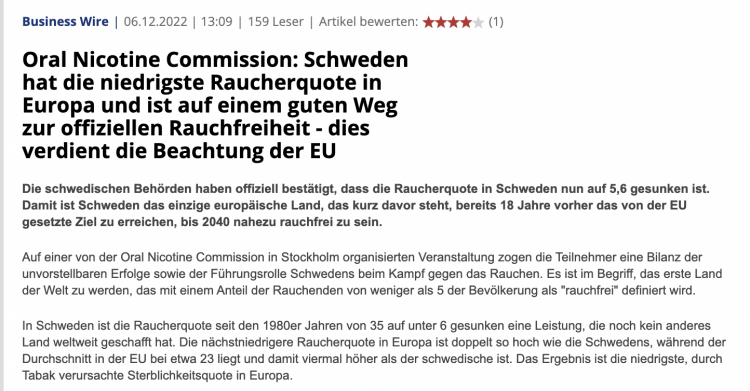
Swedish authorities have officially confirmed that the smoking rate in Sweden has now decreased to 5.6%. This makes Sweden the only European country to be on track to achieving the EU's goal of becoming smoke-free, achieving this target 18 years ahead of the 2040 deadline.
At an event organized by the Stockholm Snus Nicotine Committee, participants evaluated Sweden's incredible achievements and leadership in the fight against smoking. The country is on track to become the world's first to be defined as "smoke-free" and have a smoking population of less than 5%.
Since the 1980s, Sweden has achieved a remarkable feat unmatched by any other country in the world, reducing its smoking rate from 35% to less than 6%. The country now boasts the second lowest smoking rate in Europe, which is only half that of the next lowest country. In contrast, the average smoking rate in the EU is around 23%, which is four times higher than Sweden's. Notably, Europe also has the lowest tobacco-related death rate in the world.
On November 30, 2022, a group of leading public health experts, consumer advocates, and harm reduction professionals celebrated this achievement in Stockholm and once again called on policymakers around the world to ensure the availability of less harmful smoking alternatives as aids for quitting smoking.
Delon Human, President and Stockholm event organizer of Health Diplomats, stated during the event that if all 1.1 billion smokers worldwide were to switch to a less harmful nicotine replacement product, it could prevent disease and save millions of lives globally. Sweden has found a solution for smokers and we must work together to follow their example and save lives around the world.
This incredible success story sheds light on Sweden's secret to success, where the key factor is an open-minded attitude towards less harmful alternatives to smoking. While snus has long been at the forefront of harm reduction efforts, in recent years, nicotine pouches and e-cigarettes have become another valuable tool for Swedish smokers looking to quit.
Sweden's gradual harm reduction approach differs significantly from the measures proposed by the International Tobacco Control Organization. Advocates for harm reduction in the EU have been pushing for reductions in harm to be included in cancer prevention plans. Despite the fact that the Tobacco Control Framework Convention recognizes harm reduction as a viable option, the World Health Organization continues to refuse to acknowledge its benefits.
Professor Karl Fagerström stated during the event, "Sweden's upcoming presidency of the European Union is a great opportunity to share the country's successful stories, which accounts for 5% of the EU, with other member countries. We hope that Sweden will generously share this knowledge with other nations.
Speakers at the conference emphasized the need for evidence-based and comprehensive tobacco control policies. Therefore, it is imperative to implement the concept of reducing tobacco harm on a broader level to support smoking cessation.
Ensuring that the smoking alternatives with lower health risks are inexpensive, accessible, and easy to use, is a crucial prerequisite for Sweden's success in replicating it in other countries.
The Nicotine Oral Committee is a global nonprofit organization dedicated to assisting governments, health officials, and the public in building knowledge about nicotine oral products, challenging unfounded biases and stereotypes. The organization deals with political, scientific, consumer matters, and related product innovations. Their views are independent of any brand/manufacturer and are tailored to the individual and population health needs of adult smokers.
2FIRSTS will continue to follow and report on this topic. Updates will be available on the 2FIRSTS app. Scan the QR code below to download the app.
This document has been generated through artificial intelligence translation and is provided solely for the purposes of industry discourse and learning. Please note that the intellectual property rights of the content belong to the original media source or author. Owing to certain limitations in the translation process, there may be discrepancies between the translated text and the original content. We recommend referring to the original source for complete accuracy. In case of any inaccuracies, we invite you to reach out to us with corrections. If you believe any content has infringed upon your rights, please contact us immediately for its removal.






